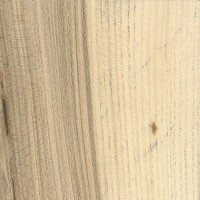 |
Common Name(s): Hackberry, Sugarberry Scientific Name: Celtis occidentalis, Celtis laevigata Distribution: Eastern North America Tree Size: 40-60 ft (12-18 m) tall, 1-2 ft (.3-.6 m) trunk diameter Average Dried Weight: 37 lbs/ft3 (595 kg/m3) Specific Gravity (Basic, 12% MC): .49, .60 Janka Hardness: 880 lbf (3,910 N) Modulus of Rupture: 11,000 lbf/in2 (75.9 MPa) Elastic Modulus: 1,190,000 lbf/in2 (8.21 GPa) Crushing Strength: 5,440 lbf/in2 (37.5 MPa) Shrinkage: Radial: 4.8%, Tangential: 8.9%, Volumetric: 13.8%, T/R Ratio: 1.9 |
Color/Appearance: Heartwood is light brown to gray. Wide sapwood is a contrasting light yellow. Susceptible to blue-gray fungal staining if not processed promptly. It’s overall appearance is similar to ash (Fraxinus spp.), and it’s sometimes used in place of ash.
Grain/Texture: Grain is usually straight or occasionally slightly interlocked, with a very coarse uneven texture.
Endgrain: Ring-porous; 2-3 rows of large to very large earlywood pores; small to medium latewood pores in wavy tangential bands; tyloses common; parenchyma vasicentric, banded (marginal); medium to wide rays, spacing wide.
Rot Resistance: Rated as non-durable to perishable. Also susceptible to fungal discoloration and insect attack.
Workability: Generally good working characteristics with both hand and machine tools, though smaller pieces with knots, or sections with interlocked grain can pose challenges in machining. Responds superbly to steam bending. Glues, turns, stains, and finishes well.
Odor: Can have a mild odor when worked.
Allergies/Toxicity: Hackberry has been reported to cause skin irritation. See the articles Wood Allergies and Toxicity and Wood Dust Safety for more information.
Pricing/Availability: Not widely available outside its natural range, Hackberry is regularly harvested and sold as utility lumber at a modest price within its natural range. Spalted and/or stained pieces are sometimes sold at an increased price. Lumber is sold interchangeably with the closely related Sugarberry (Celtis laevigata).
Sustainability: This wood species is not listed in the CITES Appendices or on the IUCN Red List of Threatened Species.
Common Uses: Furniture, boxes/crates, veneer, turned objects, and bent parts.
Comments: In terms of outward appearance, Hackberry bears a close resemblance to ash; anatomically, however, it’s closest to elm (Ulmus spp.), with the pores arranged in wavy tangential bands (ulmiform arrangement), which is characteristic of the elms. Hackberry is reputed to among the very best woods for steam bending among hardwoods native to the United States and Canada.
None available.


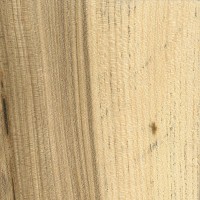
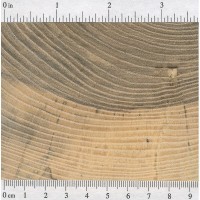
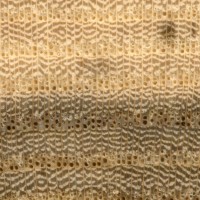
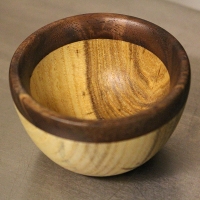



About 18 months from live removal and plain sawing to 8/4. Its now about 14% moisture content, air dried, under cover, Central Texas. I haven’t worked it yet other than running through the planer. I’m happy so far.
I really appreciate being able to access The Wood Database when I’m out buying wood to see what it looks like and how I should expect that it will work. You didn’t steer me wrong with your description of Hackberry. I’m happy the the finished project.
Richard, very nice bowl. How was the Hackberry to turn?
John, I’ve turned quite a bit of hackberry. It’s just fine. Beautiful luster
AWESOME !!
Samantha and Rob, I came to the (always reliable) Wood Database looking for info that would help on that very same topic! There is a very large Hackberry in my brother’s backyard, partially overhanging the driveway. The sap and fruits, along with bird droppings, in season, drive my long-suffering brother batty. The leaves look, to me, to be so similar to prized tropical hardwoods, particularly the rosewoods, I’d wondered if it is related, or possesses any of the same desirable characteristics, making it suitable for musical instruments. In terms of its weight and hardness, the answer would be “ideal!” The… Read more »
I have the same experience with the live tree and am in the process of taking it down. I will slowly hand mill the larger pieces. Though I have not used it for string instruments, I have handled some mandolins made by an old-timer from Arkansas. They were definitely beautiful to see and touch. The tone in the hands of talented musicians was mellow and strong. The old luthier wasn’t much of a talker, said he let strings speak for him. He did say that hackberry was easier to work than Ash and gave a better sound than any of… Read more »
Could hackberry wood, or any wood from the Celtis genus be used to make musical instruments? Such as a guitar or flute, or anything at all? I don’t need specific information about how to do it, but I would really appreciate knowing if the Celtis wood is commonly used for any musical instruments. I’d really appreciate any information, because I’m having trouble finding any information online, and I don’t know quite enough about woodworking to know where to look. Thanks!
Hi Samantha,
Wondering that myself. It would be nice to use the name “Celtis” in the building of some of my instruments since I’m in the construction of Irish citterns. Let me know if you find out. rtreeder@comcast.net
We have a huge Hackberry tree out back that will have to come down soon. Maybe big enough for quarter sawn.
All the best,
BobReeder.com
This is older thread, but I’ll comment anyway. While wind instruments can technically be made from any wood, hackberry is not considered a tonewood. Most tonewoods are quite dense, which is what makes the acoustic qualities of most (medium to small) wind instruments good. While I don’t have experience with this, I’m only guessing by looking at its specific gravity and density figures. I would also guess that its pore structure would not be ideal.
Peavey experimented using hackberry instead of ash to make T-40 bass bodies.
Fender used Hackberry for a few years in the 1970’s on P-Basses.